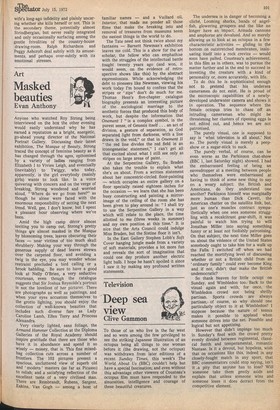Art
Masked beauties
Evan Anthony
Anyone who watched Roy Strong being interviewed on the box the other evening would easily understand why he has earned a reputation as a bright, energetic, go-ahead young director of the National Portrait Gallery. Discussing their latest exhibition, The Masque of Beauty, Strong traced the concept of feminine beauty as it has changed through the ages, epitomised by a variety of ladies ranging from Elizabeth I to Vivien Leigh, and eventually (inevitably) to Twiggy, who today, apparently, is the girl everybody (mainly girls) wants to look like. In a voice quivering with concern and on the verge of breaking, Strong wondered and worried aloud, "Where do we go from here?" as though he alone were faced with the enormous responsibility of setting the next trend. Well, gee, I don't know, but I spent a pleasant hour observing where we've been. . Amid the high camp decor almost inviting you to camp out, Strong's pretty things are almost masked in the Masque by blossoming trees, leaves obscuring their faces — near victims of too much skull shrubbery. Making your way through the generous supply of dead leaves strewn over the carpeted floor, and avoiding a twig in the eye, you may wonder whose restraint precluded a bird calling or a brook babbling. Be sure to have a good look at Nelly O'Brien, a very seductive courtesan, even though the catalogue suggests that Sir Joshua Reynolds's portrait is not the loveliest of her pictures. There are photographs as well as paintings, and When your eyes accustom themselves to the grotto lighting, you should enjoy the collection of well-known beauties that includes such diverse fare as Lady Caroline Lamb, Ellen Terry and Princess Alexandra.
Very clearly lighted, sans foliage, the Armand Hammer Collection at the Diploma Galleries of the Royal Academy should inspire gratitude that there are those who have it in abundance and spend it so wisely — money, that is. This fine mixedbag collection cuts across a number of frontiers. The 103 pictures present a Spacious, uncluttered view of superb old and ' modern ' masters (as far as Picasso) to relish; and a satisfying reflection of the excellent taste of a very civilised man. LThere are Rembrandt, Rubens, Sargent, Eakins, Van Gogh — among a host of familiar names — and a Vuillard oil, Interior, that made me ponder all those films that make the breaking into and removal of treasures from museums seem the easiest things in the world to do.
The Tate need not think twice about my fantasies — Barnett Newman's exhibition leaves me cold. This is a show for the art scholar, the fellow who can emphathise with the struggles of the intellectual battle fought twenty years ago (and won, it would seem, on the evidence of retrospective shows like this) by the abstract expressionists. While acknowledging the debt to pioneers like Newman, viewing his work today I'm bound to confess that the stripes or ' zips ' don't do much for me. Thomas Hess's five-chapter catalogue biography presents an interesting picture of the sociological marriage to the aesthetic forces that produced this body of work, but despite the information that Onement I "is a complex symbol, in the purest sense, of Genesis itself . . . an act of division, a gesture of separation, as God separated light from darkness, with a line drawn in the void," or that in Onement II "the red line divides the red field in an iconogenesiac statement," I can't get all that excited about what I still see only as stripes on large areas of paint.
At the Serpentine Gallery, Su Braden also takes the trouble to explain what she's on about. From a written statement about her concentric-circled floor-painting — which occupies an entire gallery on a floor specially raised eighteen inches for the occasion — we learn that she has been busy constructing and painting a mirrorimage of the ceiling of the room she has been given to play around in: "I shall try to use the Serpentine Gallery in a way which will relate to the place, the time allotted to me (three weeks in summer) and my own position at this time." It is nice that the Arts Council could indulge Miss Braden, but the Sistine floor it isn't.
In the East Gallery Stephen Lobb's Soft Cover hanging jungle made from a variety of soft materials, provides a lot more fun and reveals the sort of imagination that could one day produce another electric light bulb. I hope he hasn't spoiled it since I saw it by making any profound written statements.










































 Previous page
Previous page